Related Research Articles

Danburite is a calcium boron silicate mineral with a chemical formula of CaB2(SiO4)2.

The sulfide minerals are a class of minerals containing sulfide (S2−) or disulfide as the major anion. Some sulfide minerals are economically important as metal ores. The sulfide class also includes the selenides, the tellurides, the arsenides, the antimonides, the bismuthinides, the sulfarsenides and the sulfosalts. Sulfide minerals are inorganic compounds.
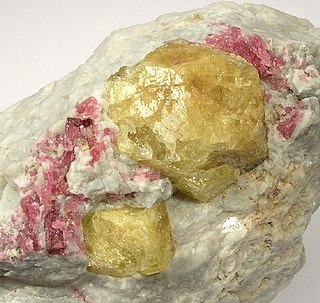
The Borate Minerals are minerals which contain a borate anion group. The borate (BO3) units may be polymerised similar to the SiO4 unit of the silicate mineral class. This results in B2O5, B3O6, B2O4 anions as well as more complex structures which include hydroxide or halogen anions. The [B(O,OH)4]− anion exists as well.
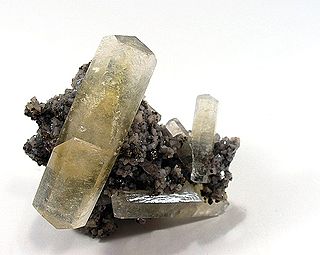
Carbonate minerals are those minerals containing the carbonate ion, CO2−
3.
Arsenate minerals usually refer to the naturally occurring orthoarsenates, possessing the (AsO4)3− anion group and, more rarely, other arsenates with anions like AsO3(OH)2− (also written HAsO42−) (example: pharmacolite Ca(AsO3OH).2H2O) or (very rarely) [AsO2(OH)2]− (example: andyrobertsite). Arsenite minerals are much less common. Both the Dana and the Strunz mineral classifications place the arsenates in with the phosphate minerals.
An arsenide mineral is a mineral that contains arsenide as its main anion. Arsenides are grouped with the sulfides in both the Dana and Strunz mineral classification systems.
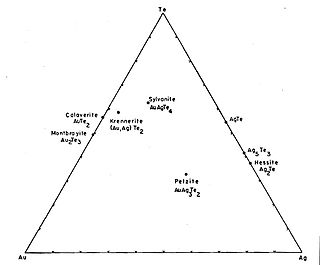
A telluride mineral is a mineral that has the telluride anion as a main component.
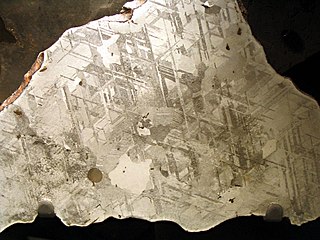
Taenite is a mineral found naturally on Earth mostly in iron meteorites. It is an alloy of iron and nickel, with a chemical formula of Fe,Ni and nickel proportions of 20% up to 65%.

Breithauptite is a nickel antimonide mineral with the simple formula NiSb. Breithauptite is a metallic opaque copper-red mineral crystallizing in the hexagonal - dihexagonal dipyramidal crystal system. It is typically massive to reniform in habit, but is observed as tabular crystals. It has a Mohs hardness of 3.5 to 4 and a specific gravity of 8.23.

Nickel–Strunz classification is a scheme for categorizing minerals based upon their chemical composition, introduced by German mineralogist Karl Hugo Strunz in his Mineralogische Tabellen (1941). The 4th and the 5th edition was also edited by Christel Tennyson (1966). It was followed by A.S. Povarennykh with a modified classification.
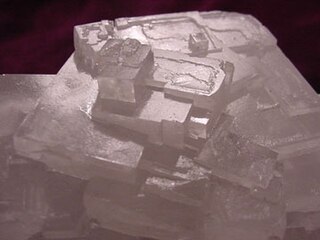
Halide minerals are those minerals with a dominant halide anion. Complex halide minerals may also have polyatomic anions.
The sulfarsenide minerals are a subgroup of the sulfide minerals which include arsenic replacing sulfur as an anion in the formula. Antimony and bismuth may occur with or in place of the arsenic as in ullmannite. The chemical formula of a sulfarsenide looks like a sulfosalt, however the structures are distinctly different. In sulfosalts the arsenic replaces a metal ion.

Coloradoite, also known as mercury telluride (HgTe), is a rare telluride ore associated with metallic deposit. Gold usually occurs within tellurides, such as coloradoite, as a high-finess native metal.

Native element minerals are those elements that occur in nature in uncombined form with a distinct mineral structure. The elemental class includes metals, intermetallic compounds, alloys, metalloids, and nonmetals. The Nickel–Strunz classification system also includes the naturally occurring phosphides, silicides, nitrides, carbides, and arsenides.

Daubréelite is a rare sulfide mineral. It crystallizes with cubic symmetry and has chemical composition of Fe2+Cr3+2S4. It usually occurs as black platy aggregates.
Some organic compounds are valid minerals, recognized by the CNMNC (IMA).
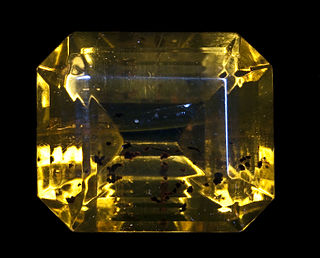
An organic mineral is an organic compound in mineral form. An organic compound is any compound containing carbon, aside from some simple ones discovered before 1828. There are three classes of organic mineral: hydrocarbons, salts of organic acids, and miscellaneous. Organic minerals are rare, and tend to have specialized settings such as fossilized cacti and bat guano. Mineralogists have used statistical models to predict that there are more undiscovered organic mineral species than known ones.

Ramsdellite (Mn4+O2) is an orthorhombic manganese dioxide mineral. It is relatively uncommon, and is usually found in deposits containing other manganese oxide crystals.
Dana's classification is a mineral classification developed by James Dwight Dana. It is based on the chemical composition and structure of minerals. It is mainly used in English-speaking countries, especially in the United States.
References
- ↑ "Minerals Arranged by the New Dana Classification". Webmineral. Retrieved 17 May 2021.
- ↑ "Minerals arranged by the Nickel-Strunz (Ver10) Classification System". Webmineral. Retrieved 17 May 2021.